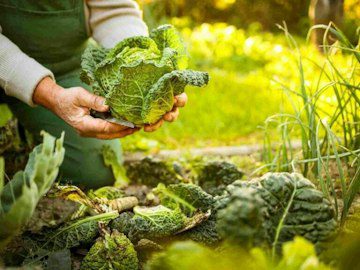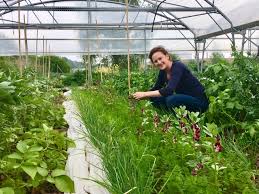Permaculture and Regenerative Agriculture are two important methods of farming and gardening that aim to help the Earth stay healthy and provide food for people. They are like nature’s way of farming, and they use simple and smart ideas to do it.
Permaculture is a way of growing food and taking care of the land in a special way. It’s like making a little ecosystem in your garden or on your farm. Instead of using chemicals that can hurt the land and the creatures that live in it, permaculture uses natural ways to help plants grow.
For example, in permaculture, people may plant different kinds of plants together to help each other. Some plants might give shade to others, and some plants can protect against pests. This is like how a forest works – there are many kinds of plants and animals living together, and they help each other out.
Regenerative Agriculture is another way of farming that takes care of the land. It’s all about improving the soil, which is like the Earth’s skin, so that it can keep growing good food for us. Regenerative farmers use things like compost and cover crops to make the soil happy.
They also use smart ways to take care of water. They make sure water stays in the ground, so it’s there for the plants when they need it. This is important because water is precious, and we don’t want it to wash away.
Both permaculture and regenerative agriculture want to make sure the land is healthy for a long time. They don’t want to hurt the Earth or take away too much from it. They want to give back and help nature do its thing.
People who practice permaculture and regenerative agriculture are like Earth’s friends. They understand that the Earth gives us food and a home, so we should take care of it. These ways of farming and gardening are simple and wise, and they help us and the Earth live together in harmony.
Read Also: Otterhound Dogs: Description and Complete Care Guide
Benefits of Permaculture and Regenerative Agriculture

Permaculture and Regenerative Agriculture offer numerous benefits for the environment, communities, and agriculture itself. Here are some of the key advantages:
1. Sustainable Food Production: Permaculture and Regenerative Agriculture methods promote long-term food production without harming the environment. They focus on working with nature, not against it.
2. Soil Health: Both methods prioritize soil health. By improving soil structure and fertility, they create a resilient foundation for agriculture. Healthy soil can retain more water, making farms more drought-resistant.
3. Biodiversity: Permaculture and Regenerative Agriculture encourage the planting of a wide variety of crops and the use of native plants. This fosters biodiversity, which is crucial for the health of ecosystems and pollinators.
4. Reduced Chemical Use: These methods minimize or eliminate the need for synthetic chemicals like pesticides and herbicides. This reduces pollution, protects beneficial insects, and prevents the development of resistant pests.
5. Water Management: They focus on water conservation and management. By using techniques like rainwater harvesting and swales, they reduce water wastage and the risk of erosion.
6. Carbon Sequestration: Regenerative Agriculture can sequester carbon in the soil, helping mitigate climate change. Healthy soils store more carbon, reducing greenhouse gas emissions.
7. Resilience to Climate Change: These methods often lead to more resilient farms. By diversifying crops and enhancing soil health, they can withstand extreme weather events better.
8. Local and Sustainable Communities: Permaculture and Regenerative Agriculture support local economies by encouraging small-scale, sustainable farming. This can enhance community food security and reduce the environmental impact of transporting food long distances.
9. Healthier Food: These methods tend to produce healthier, more nutritious food. The absence of synthetic chemicals and the focus on soil health can lead to better quality crops.
10. Reduced Waste: Permaculture and Regenerative Agriculture promote recycling and minimizing waste. For example, they often use composting to recycle organic matter back into the soil.
11. Empowerment: They empower farmers and gardeners by teaching them to work in harmony with nature. These methods can be applied by individuals, communities, and large-scale agriculture, providing a sense of control and connection to the land.
12. Cost-Effective: Over time, these methods can reduce farming costs. Less need for synthetic inputs and the ability to reuse resources like water and organic matter can improve the bottom line.
13. Erosion Control: By protecting the soil and reducing the risk of erosion, Permaculture and Regenerative Agriculture help maintain fertile land for future generations.
In addition, Permaculture and Regenerative Agriculture offer a holistic and sustainable approach to farming that benefits the environment, communities, and the quality of our food. These methods promote harmony with nature and aim to create a healthier and more resilient food system for all.
Read Also: Pembroke Welsh Corgi Dogs Description and Complete Care Guide
Techniques Used in Permaculture and Regenerative Agriculture

Permaculture and Regenerative Agriculture employ various techniques to achieve their goals of sustainable and environmentally friendly farming and gardening. Here are some key techniques associated with these practices:
Permaculture Techniques
1. Polycultures: Planting a diverse mix of crops in the same area, which helps deter pests, improve soil health, and maximize space.
2. Companion Planting: Growing plants together that support each other, such as planting basil near tomatoes to deter pests.
3. Sheet Mulching: Layering organic materials like cardboard, compost, and mulch to suppress weeds and build healthy soil.
4. Hugelkultur: Creating raised garden beds filled with logs and organic matter, which gradually decompose and improve soil fertility.
5. Keyhole Gardens: Circular garden beds with a compost basket in the center, making it easy to add organic matter and water efficiently.
6. Swales: Ditches dug on contour to capture and redirect rainwater, preventing erosion and recharging groundwater.
7. Guilds: Planting groups of plants that work together to benefit each other, such as fruit trees with nitrogen-fixing plants and ground covers.
8. Food Forests: Designing landscapes that mimic natural forests but are filled with edible plants, creating a self-sustaining ecosystem.
9. Aquaponics: Combining aquaculture (raising fish) with hydroponics (growing plants in water) to create a closed-loop system.
Regenerative Agriculture Techniques
1. Cover Cropping: Planting crops like legumes or grasses between cash crops to protect the soil, fix nitrogen, and improve soil structure.
2. No-Till Farming: Reducing or eliminating plowing and tilling to preserve soil structure, reduce erosion, and sequester carbon.
3. Crop Rotation: Changing the type of crops grown in a field to break pest and disease cycles and maintain soil health.
4. Composting: Turning organic matter into nutrient-rich compost to enhance soil fertility.
5. Managed Grazing: Rotating livestock through pastures to prevent overgrazing and improve soil health.
6. Agroforestry: Integrating trees or woody shrubs with crops or livestock, providing multiple benefits like shade, windbreaks, and improved soil quality.
7. Regenerative Grazing: Mimicking the natural movement and behavior of herds to regenerate grasslands and improve soil.
8. Silvopasture: Combining trees, forage, and livestock to create a sustainable and productive system.
9. Conservation Tillage: Reducing soil disturbance by using minimal or zero tillage methods to conserve moisture and prevent erosion.
10. Integrated Pest Management (IPM): Using a combination of techniques, including biological control and habitat manipulation, to manage pests without relying on chemicals.
These techniques are adaptable and can be applied in various combinations, depending on the specific goals and conditions of the farming or gardening operation. They prioritize sustainability, soil health, and ecosystem resilience while reducing the need for synthetic inputs.
